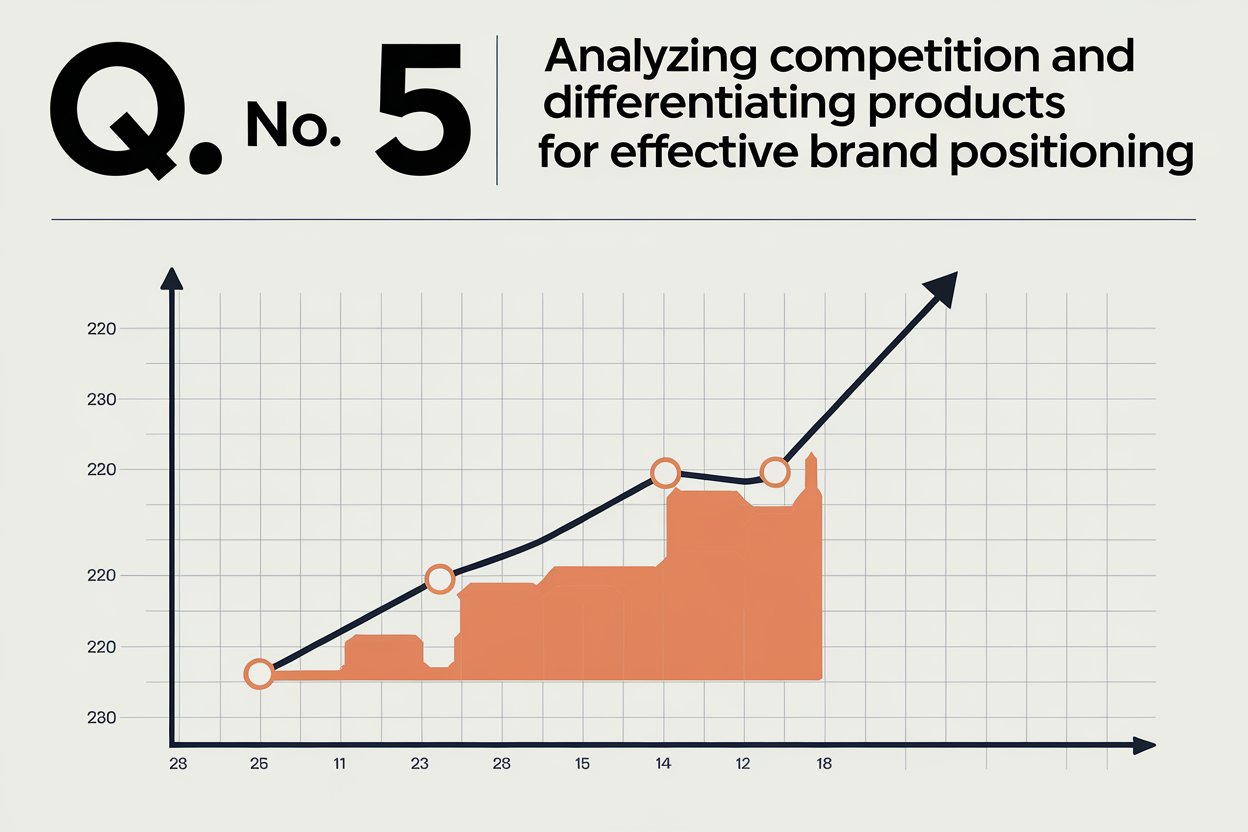Q. No. 5 Analyzing Competition and Differentiating Products for Effective Brand Positioning

How Marketers Analyze Competition and Differentiate Products for Successful Brand Positioning
Brand positioning involves creating a unique and memorable image of a product in the minds of customers. For successful positioning, marketers must first analyze the competition and then differentiate their products effectively. Here’s how they approach this process:
1. Analyzing Competition
Marketers must thoroughly understand the competitive landscape to position their products effectively. The key steps include:
- Competitor Identification: Marketers identify direct and indirect competitors offering similar products or services. This includes both current competitors and potential future entrants.
- SWOT Analysis: Conducting a SWOT (Strengths, Weaknesses, Opportunities, Threats) analysis for competitors helps marketers identify areas where they can capitalize on weaknesses or avoid direct competition where rivals are strong.
- Market Mapping: Positioning maps (or perceptual maps) are tools that help visualize the positioning of competitors along key dimensions like price, quality, and features. This helps marketers see gaps in the market that their brand can fill.
- Customer Perception: Analyzing how customers perceive competing products helps identify the attributes they value most. Tools like surveys and focus groups can provide insights into customer preferences and competitor weaknesses.
- Benchmarking: Marketers compare product features, pricing strategies, distribution channels, and promotional efforts of competitors to understand where their product stands in relation to others in the market.
2. Differentiating Products for Successful Positioning
After understanding the competition, marketers focus on differentiation to carve out a unique market position. Effective differentiation involves:
- Unique Selling Proposition (USP): The USP is the defining feature or benefit that sets a product apart from its competitors. It could be product quality, innovation, convenience, price, or a specific feature that competitors lack.
- Target Audience Focus: Marketers tailor positioning strategies to meet the specific needs and preferences of the target audience. Segmentation allows brands to focus on niches, avoiding direct competition with mass-market players and appealing to a specific customer group.
- Brand Personality and Values: Marketers build a brand’s personality, which encompasses the emotional and psychological attributes of the brand. Aligning a brand with certain values or lifestyles can differentiate it, especially in markets where functional differences are minimal.
- Innovation and Design: Product innovation, including new features, cutting-edge technology, or design improvements, can differentiate a brand. Companies often invest in research and development to stay ahead of the competition and offer superior products.
- Customer Experience: Beyond product features, the overall customer experience can serve as a differentiator. This includes service quality, ease of use, delivery speed, and post-purchase support. Positive customer experiences foster loyalty and differentiation.
- Pricing Strategy: Price can be used to differentiate a product. Premium pricing positions a brand as high-end or luxury, while competitive pricing or discounts can attract price-sensitive consumers. Pricing must align with the brand’s value proposition.
- Brand Communication: Effective marketing campaigns and brand messaging are critical to reinforcing a product’s differentiation. Storytelling, brand values, and consistent messaging through advertising, social media, and public relations build the brand image over time.
3. Reinforcing Positioning Through Key Metrics
Marketers track specific performance metrics to ensure successful brand positioning:
- Market Share: The percentage of total sales a product holds in relation to competitors.
- Customer Loyalty and Retention Rates: The degree to which customers consistently choose the brand over competitors, indicating successful positioning.
- Brand Awareness: How well customers recognize and recall the brand compared to competitors.
- Perceived Value: Customer perceptions of a product’s value relative to its price and competition.
- Customer Satisfaction Scores: Feedback from customers about their satisfaction with the product and overall brand experience.
Conclusion
Successful brand positioning requires a comprehensive analysis of the competition and strategic differentiation based on unique features, customer needs, and brand identity. By leveraging competitive insights and offering a clear value proposition, marketers can establish a strong, lasting position in the minds of customers.